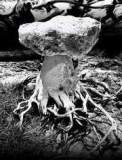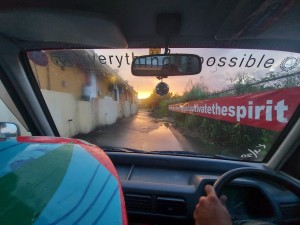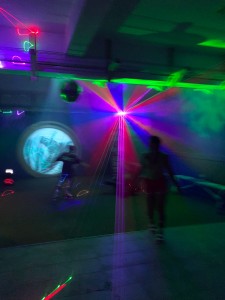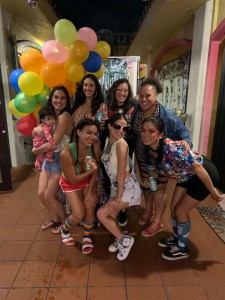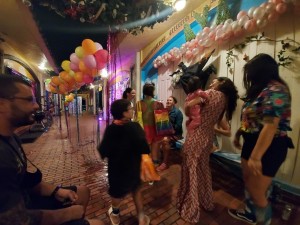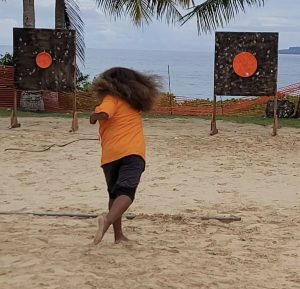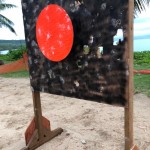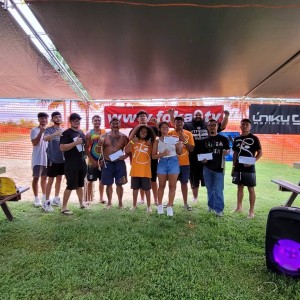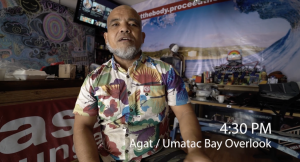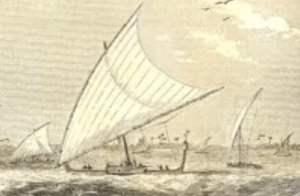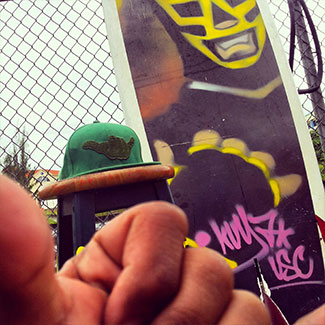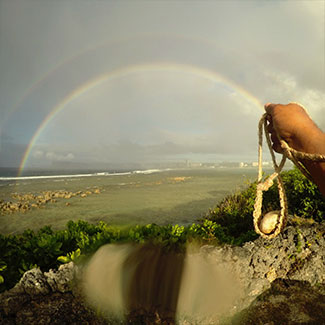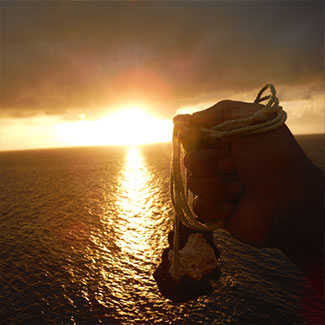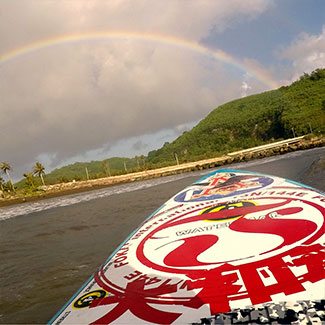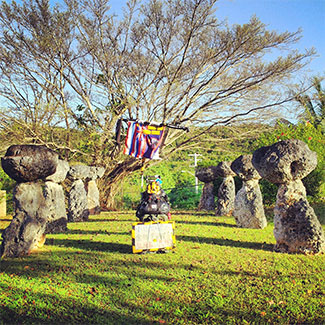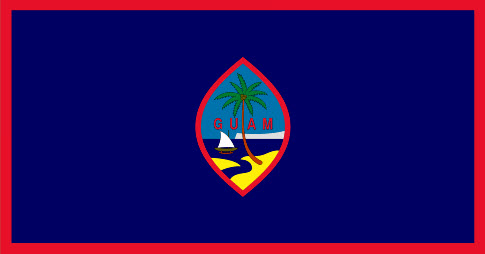Brief of Beginning of FOKAI
December 10, 2021 by admin
Filed under Special Forces
1. How did “Fokai” begin, and who were the important names behind the start of your brand.
Fokai Started as a seed planted in surfing and sprouted in Martial Arts. Important names were Roman Dela Cruz, Patrick Fleming, Steven Shimizu, and John Calvo
2. What year did you start up, describe how you started up and why, and what was the look of your first piece of merchandise?
We were conceived circa 1991 but started mid 1997. A bunch of guys looking to put a quality local label behind quality Guam ventures
3. How much did they sell for? Who bought them?
15dollars a t shirt. Friends and family, friends of family, and a family of friends
4. What influenced the brand then, and what continues to influence it now?
Perseverance and Initiative for sure but largely–The positive landmarking of Guam, the cultivation of Guam, The growing standard of quality apparel. I think now were also raising our standard of product. years int he industry and exposure to the world industry have us paying attention to finer details as well as setting higher goals for our merchandise. partly for the brand and just as importantly for our supporters.
5. Where has Fokai reached out to? California? Japan?
Saipan, Philippines, other parts of Asia, Japan, Bali,Hawaii, California, Ireland,Different sports and athletes? anything that involves sacrifice and spirit
Competitions and charities?
Have had some ventures into the Hip-Hop subculture and Drift Racing , Have taken a larger role with the Cocos Crossing, Marianas Open, Rollapalooza in the Philippines, and some Martial Arts events in Europe, Hawaii, and California etc.
6. When did you establish the first Fokai shop, and how have you guys grown now? i.e. fokai femme.
Moved in there October of 2003. Put a stronger team behind the label establishing Grasshopper Inc and Started a Japan office and shop in 2005. Opened up a Shop in San Diego in 2006. Opened our second flagship store in 2008. Most recently opened FokaiFemme in December of 2009
7. How does it feel launching the fokai femme brand and the new location?
The financial pressures are definitely there. But our main shop in Tumon was a bit too small. we had merchandise in the back that we couldn’t even display in the front. We wanted to give more attention detail to our women’s and children’s line and thought it would best happen by the beach. FokaiFemme needed to grow in its own light so we thought moving it not too far from Home base would help the situation.
Loving the new location. the structure itself is a reverse layout of Shop 1 and its on the opposite side of the same building. so in a sense, in this new venture, we can literally express another side of Fokai.
8. whose been a big help for you the last few years?
God imminently. but Carlo Dela Cruz, Stephen Roberto, Tony Anderson, Hideaki Shiina, Enson Inoue, Wayan Kurniawan, Ryan Johnson, Steve Shimizu and Families,Richard Chou, Kie SusuicoGuam Shipyard, Purebred Lloyd Irvin, Undisputed, Spike22, WaveHouse, Ralphy’s, Marty’s, etc. with a Capitol ET and C. the list goes on.
9. what is the target trend of the brand (customer wise: i.e.: college kids on vacation, military personnel leaving the island, tourists) and what is something most people may not know (sponsorships of sports, japan brand/cali brand, etc).
No target trend. we just try to do what we love and celebrate the human spirit as best in fashion and function under proper inspiration and at our capacity. In the end we want to deliver a sincere and quality product and label that well represents our movement and island
something to know?
we want to help save the world
Saina Maase! Thank you! Fokai Familia!
November 26, 2021 by admin
Filed under Special Forces
Hafa Adai,
We’d like to embrace the opportunity to say thanks to all the support from our people over the years. Fokai has always been and always be a from-the-heart process in Celebrating Life and sharing in and aiming for the good vibe. It has always been our honor to see the love that passes through our doors–its a love that we extend in our product and development.
Respect + Strength & Honor = Call Of Duty.
Proud to Rise and Fall and Rise again with you.
ForLife–Happy Thanksgiving
Roller Disco Halloween Night at The Fokai Shop
November 5, 2021 by admin
Filed under Special Forces
CNMI’s first ever Marianas sling tournament in Tinian
October 27, 2021 by admin
Filed under Special Forces
Keith Nabors, who organized the competition, said the event’s 21 competitors from Saipan, Tinian, Rota, and Guam competed in three categories: men’s open, women’s, and under 16 and a total of 16 competitors walked away with prizes, and non-competitors were treated to sling stone lessons and free slings from Nabors.
The competitors had to stand 75 feet away from a large target with a bullseye in the middle, with zero points awarded for misses, one point for hitting the board, and two points for hitting the bullseye. Every competitor competed in five rounds, three throws each round, to post up the best score possible.
Keith Nabors was very pleased with the turnout and with how the event was run and that Tinian Mayor Edwin P. Aldan himself told Nabors that he would like to see the sling stone competition return for 2022 Taga Fest.
“It was awesome, and I’m totally excited for the things to come. …Next year, hopefully we can get more competitors out and more people interested. …It’s just awesome to share the culture and get the kids back into their roots, and I just want to see the sport develop,” he said.
Keith Nabors added that he’d like to see sling stone throwing be part of next year’s Pacific Mini Games, which Saipan will host, and he has aspirations of sending some of the CNMI’s young slingers to an international sling stone throwing competition in Spain sometime next year.
Acho Marianas September 11th 2021 Agat / Umatac Bay Overlook Slinging Event
September 9, 2021 by admin
Filed under Special Forces
Join us on Sept 11th 2021 at 4:30 PM at Agat / Umatac Bay Overlook.
Acho Marianas will be slinging seeds for distance vegetation and to commemorate & pay homage to events transpiring in 2001 and 1671 in ancient Chamorro history. If you have any indigenous seeds available, please bring them to sling. Please come in small groups. Social distancing will be observed. See you there!
On September 11th, 1671, it is said that 2,000 warriors surrounded Hagåtña with the intent of freeing Hurao and expelling the Spanish. Read full article here: http://minagahet.blogspot.com/2019/06/wake-me-up-when-remember-september-again.html
Professor Stephen Roberto Retirement Speech July 3rd 2021
July 4, 2021 by admin
Filed under Special Forces
Professor Stephen Roberto Retirement Speech July 3rd 2021 | Purebred Jiujitsu Guam
Ancient CHamoru Canoe Builders: Agad’na
March 15, 2021 by admin
Filed under Special Forces
From: Guampedia
The ancient CHamorus who were skilled at canoe building and navigation were called agad’na. Early European accounts regularly marveled at these CHamoru vessels, William Dampier, saying in 1681 for instance that:
One cannot stop talking about their great velocity, craftsmanship and lightness, because in the whole universe I do not believe there is a thing equal to them in nimbleness and swiftness.
Another visitor, Woodes Rogers in 1711, said:
The Governor presented us with one of their flying prows, which I shall describe here because of the oddness of it. The Spaniards told me it would run twenty leagues per hour, which I think too large; but by what I saw they may run twenty miles or more in the time, for when they viewed our ships, they passed by us like a bird flying. These prows are about thirty foot long, not above two broad, and about three deep. They have but one mast which stands in the middle, with a mat sail, made in the form of a ship’s paddle to steer her, so that when they go about, they don’t turn the boat as we do to bring the wind on the other side, but only change the sail, so that the Jack and sheet of the sail are used alike. The boat’s head and stern are the same, only they change them, as occasion requires, to sail either way. For they are so narrow that they could not bear any sail, were it not for booms that run out from the windward side, fastened to a large log shaped like a boat, and nearly half as long, which becomes contiguous to the boat. On these booms a stage is made above the water on a level with the side of the boat, upon which they carry goods or passengers.
They were called “flying proas” because of their speed, and possessed three technological innovations which made this label well deserved:
- Their hull was asymmetrical to counter the drag of the outrigger float.
- CHamorus used triangular sails to increase speed and allow for a closer sail to the wind.
- The proas tacked by moving the sail from one end of the canoe to the other. This is called shunting and is done because the outrigger float must always be to windward.
So fast were these vessels that one voyage from Guam to Manila reportedly took only four days, which means they traveled more than twenty miles per hour.
These canoes were vital to the survival of CHamorus because they facilitated transport and trade among islands and allowed them to fish beyond the reef.
Ancient CHamorus had at least six types of canoes: sakman, leklek, duding, duduli, panga and galaide. The sakman was the largest and most impressive, regularly measuring more than 40 feet, some reportedly holding a 100 men, ideal for long voyages, and deep sea fishing. Leklek, duding, and duduli were smaller vessels for shorter voyages. The panga is a duduli without a sail. The galaide, also without a sail, is a small vessel. Both the panga and galaide were used within the reef.
Canoe construction and navigation were considered men’s tasks, and most likely specialized to a select few. The learning of these skills were either passed down from father to son, or a part of a young man’s education in the guma’ uritao or men’s house.
After a suitable tree was cut down, usually dokdok or breadfruit, a skilled carver would begin to shape the canoe using a higam or shell adze as well as fire. If the canoe was to be longer than eighteen feet, more than one tree trunk would be needed and one of the most difficult tasks was making sure that different sections of the hull would fit securely. These sections were lashed together and then sealed using plant fibers and tree sap.
In addition, pieces such as the palu or mast, the outrigger, and the umulin or rudder would have to be carved and attached. The hulls would be colored in white, black, red or orange by using red dirt, afok or lime, coconut oil and soot, which both beautified them and offered protection from bad weather. Women were responsible for the construction of the layak or sail. They would weave together small sections of akgak or pandanus mats, to form a huge triangle which would then be attached to the palu.
Ancient CHamorus, like other Micronesian islanders, used an impressive array of skills to navigate their magnificent vessels. Most important was the use of the rising and setting of stars to plot their course, but also vital were the abilities to discern differences in wave patterns, sea life, ocean color, and cloud formations.
By Michael Lujan Bevacqua, PhD
From the Desk of Guam’s Historian: CHamoru oral histories
March 15, 2021 by admin
Filed under Special Forces
Guampedia.com March 2021 Newsletter
CHamoru oral histories are a
powerful tool in the interpretation
of our sainas (elders), finaloffan
(past) and hinanau (a journey).
For more than five decades,
I have emphasized using
Finu’håya (CHamoru language)
in understanding and learning
of the CHamoru finaloffan and
hinanau. There is no alternative
since our saina did not write their
past. In CHamoru, there is a very
powerful proverb, Ti Mamaigu’
Si Yu’us (God does not sleep!).
In learning and understanding
CHamoru history, I restated the
proverb as, Ti Man Mamaigu’ I
Man Saina-hu (CHamoru elders
do not sleep!). This has been my
relationship with them since I can
remember.
In revisiting an event that
occurred 500 years ago, I could
literally hear finu’-ñiha (their
voices) in my writing and my
reflections with their emphatic
statements. Atan i ha’åni?
(Review the dates?). Atan håyi
I man tautau gi lagu? (Who
were the people who arrived
from the direction of the eastern
horizon?) Man håyi? (Who are
they?). Yanggin un atan maulik,
un sodda’ i ineppi’! (When you
search intensely, you will have the
answer)! And I did!
Of the 270 crew member
expedition, there was one crew
member that is linked intimately to
what occurred 500 years ago. His
name was Enrique de Malacca,
a Malaysian, known to his people
as Awang Pawgilinan. He and I
are both distant CHe’lu (siblings)
of the Proto-Austronesian race.
Our saina’ reached the shores of
thousands of islands in Oceania.
Of the same ancestry, I speak
CHamoru and Enrique spoke
several Malay dialects, all of which
are Proto-Austronesian languages.
When I reviewed various Malay
dictionaries, I was amazed by a
pivotal lexicon shared by CHamoru
and Malay. These lexicons
include the human anatomy, the
constellations, pronouns, and
numerical systems, to cite a few.
In any inatulaka (trade), numerical
systems are indispensable.
After realizing and knowing
our ancestral relationship,
other questions unfolded in my
search for enlightenment. One
question was, who among the
crew members who were able to
communicate with my saina 500
years ago? Enrique!
In my interpretation of the event
500 years ago, Enrique perhaps
said the following; “Magellan, the
CHamoru(s) speak a language I
understand!” Sure enough, after
the Expedition departed Las Islas
Marianas three days later, they
reached Las Islas Filipinas within
10 days, arriving March 16, 1521.
Thus leading them to the Spice
Islands.
Why was this account not
written or more documented?
Because Enrique was not an
integral part of the narrative of
the Expedition. The focus was on
Magellan and Elcano. Enrique
was not even a subtitle to the Las
Islas Marianas. The chroniclers,
including Antonio Pigafetta, were
focused on the deeds and merits
of the lead explorers, all who
were Europeans.
I have always questioned
why they only made a three day
layover in Las Islas Marianas,
based on CHamoru ocean
voyaging traditions. If indeed the
chroniclers were truly descriptive
of the expedition’s plights, they
would have had no choice but
to remain in Las Islas Marianas
longer to recuperate. However,
they did not and departed after
three days.
As a CHamoru, I know our
saina would not risk the health
of their crew. Their crew comes
first before the objective of the
voyage. The only reason and
explanation I can think of is that
Enrique was instrumental in the
three day layover. He must have
convinced Magellan and Elcano
of the proximity and just days
within reach of the Spice Islands.
Who else on the expedition had
the knowledge?
There is another pivotal
storyline regarding Enrique.
Enrique was Magellan’s esklåbu
(slave). As Magellan’s esklåbu,
Enrique was likely a part of the
expedition to be interpreter once
the expedition reached the Spice
Islands.
Enrique is our link to the first
circumnavigation of the globe.
He may also be the first Malay to
circumnavigate the globe. As a
CHamoru, as a part of the Proto-
Austronesian people, my pride in
Enrique is endless. Enrique and
guåhu (I) are CHe’lu only divided
by spaces of time, ocean and
land. We are both Austronesian!
Finally and emphatically,
I also became an esklåbu
through Western expansionism
and colonialism. I became the
“governed!”
Gi mina’åsi’, la sangri yåma yan
fanatahguiyan I ha’åni
(With grattitude, the blood calls
the winds of change).
500 ANNIVERSARY OF THE ARRIVAL OF THE SPANIARDS IN GUAM
March 15, 2021 by admin
Filed under Special Forces

The Spanish training ship “Juan Sebastián Elcano” arrives at the Umatac Bay of the island of Guam, thus commemorating the 500 th anniversary of the arrival of the Spaniards in these islands called as a whole Las Marianas, located in the area of Micronesia (Pacific ocean). It was on March 6, 1521, after four months without stepping on land, that two Spanish ships arrived there.
Curiously, Rear Admiral Santiago Barber López, who is an advisor for the V Centennial Commemoration, is also now on the island attending the different events that take place there during these days. He is a Majorcan who is a prominent military officer of the Spanish navy in where it commemorates the trip that our compatriots made now five centuries ago, in the first travel around the world, a trip that began on August 15th, 1519 with Fernando de Magallanes at the head of several ships and a total of 239 sailors. When he died on his way back Juan Sebastián Elcano took his place, arriving in Seville on September 6th, 1522, with only 18 crew members left in the Victoria ship.
To be honest a few years ago I had no idea that there was an island called Guam, but coincidences of life and the fact that the Chamorros of this island also have a tradition of throwing stones with the sling, are the reasons why already there is a bond between Guam and the Balearic Islands. Several of its slingers have visited our islands in the Mediterranean and there is continuous contact for future sporting and cultural events between the Balearic Islands and the island of Guam.
For example, this same 500th anniversary, and had it not been for the pandemic, we would surely have traveled from various European countries to the Pacific Ocean to enjoy and compete with our colleagues in these important and historical moments.
There are more than a dozen who have visited Mallorca and Ibiza, Román de la Cruz, Vicente Rosario, Tony, Josua and Linda Pérez, among others, are the ones that we keep fond memories of.
Speaking of names, precisely, in addition to sling shooting and other customs, what surprised me the most, are these names and surnames that many of them have, which are completely Spanish and which they have maintained since this time called the Philippines.
The common history of Spain and Guam lasted until 1898. The island currently belongs to the United States (due to its strategic location) and there is even a major military base located there.
In Guam the traditional and ancient language is the Chamorro but English is also spoken and one can even find some minority examples of Spanish.
The slinging clubs of the Balearic Islands and all their members ,send a big hug to the friends of the island of Guam.
Congratulations to both Guam and Spain for this 500th anniversary!
Pep Ribas Ribas
Balearic Islands
Spain
Spanish Navy ship Juan Sebastián de Elcano arrives in Marianas waters!
March 1, 2021 by admin
Filed under Special Forces
Spanish Navy tall ship Juan Sebastián de Elcano arrived Feb. 26, 2021 in Guam’s waters to commemorate the 500th anniversary of Magellan’s visit to the island.

